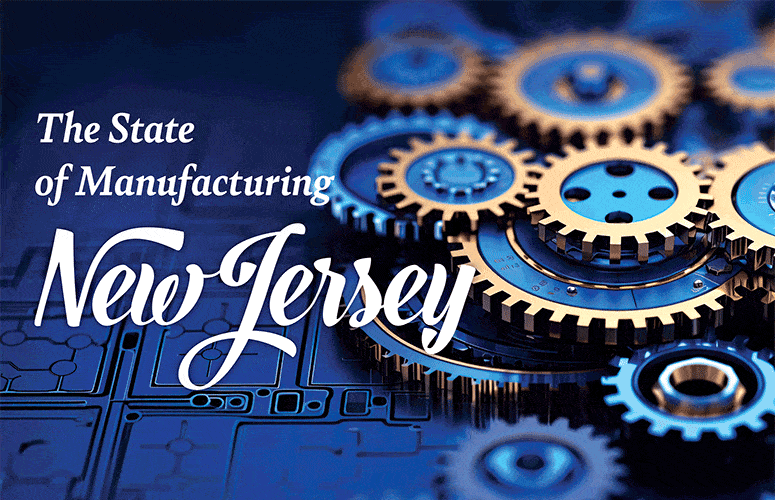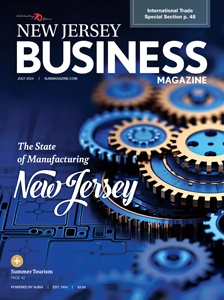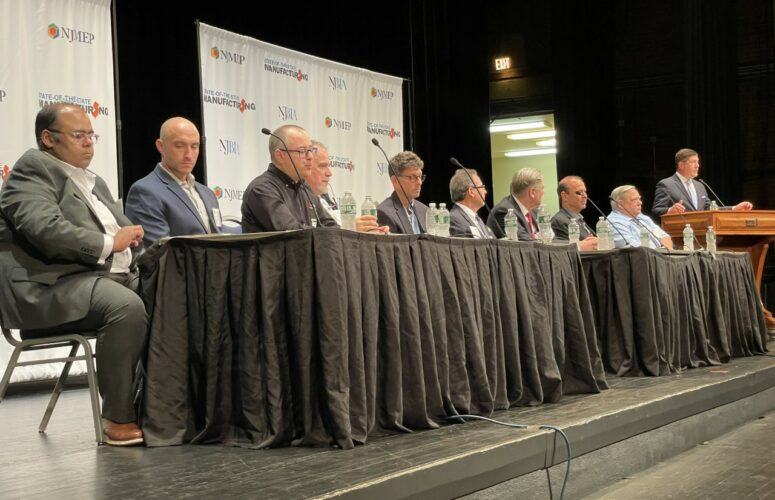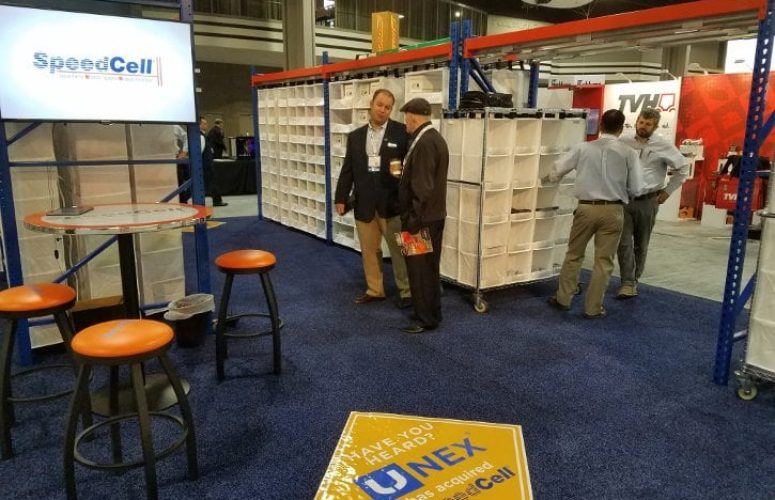
New Jersey: The State of Manufacturing
Efforts within NJ aim to support manufacturers, despite myriad challenges impacting the industry.
By Jim Pytell, Managing Editor On Jul 1, 2024Manufacturing has played a critical role in New Jersey’s history. During the early 1800s, a time of great growth and prosperity for the state, manufacturing led the way. Paterson became a textile center and later became known for producing trains and silk. Trenton produced clay products, iron, and steel. Camden, Elizabeth, Jersey City, Newark, and Passaic all became major manufacturing centers during the 1800s. Between 1900 and 1930, New Jersey’s population more than doubled, and manufacturing became a $4 billion industry.
Today, there are more than 9,000 manufacturers currently operating in the state, employing approximately 236,000 people, and accounting for $54 billion in GDP, according to statistics from the New Jersey Department of Labor (DOL).
Echoes from the state’s early manufacturing roots can still be seen today, namely the iconic lettering first installed on the Lower Trenton Bridge in 1935 which, since updated, now reads: “Trenton Makes, The World Takes.”
The motto serves as a reminder of the foundations that the state was built on, even though there has been a mounting slate of challenges that include: overall affordability, overregulation, a workforce shortage, supply chain issues, and more.
“I say we really need to make that [sign] mean something again,” said Sen. Michael Testa (R-1), who spoke at this year’s State of the State of Manufacturing day in Trenton. This collaborative event powered by the Manufacturing Counts partnership between the New Jersey Business & Industry Association (NJBIA) and the New Jersey Manufacturing Extension Program (NJMEP), gave manufacturers the unique opportunity to speak directly with legislators about the issues they are facing today.
Finding and Developing a Workforce
Perhaps the biggest challenge the industry is facing is finding enough workers.
“It is a nationwide issue,” says Todd R. Bingham, president & CEO, Utah Manufacturers Association, and chair of this year’s COSMA event. “Whether you’re in New Jersey or whether you’re in Salt Lake City, Utah, it’s the same challenge.”
Peter Connolly, NJMEP center director and CEO, echoes these sentiments, adding that since the pandemic, people want to work from home, which has compounded the issue.
According to Testa, part of the solution to the workforce issue is changing the conversation on manufacturing.
“In this post COVID era, we really need to highlight our manufacturers,” he says. “We need to let young people know that manufacturing is a viable career option and not just a dead-end job. They need to see that it is a career that allows you to thrive.”
On average, manufacturing jobs have higher wages and benefits than other private sector jobs, with an average wage of $74,000, according to DOL.
The manufacturing workforce is also aging, with Connolly saying that NJMEP members will have to replace their workforce in the next 10 years due to retirements.
As such, NJMEP has partnered with the New Jersey Economic Development Authority (NJEDA) in a Makers & Creators tour. “It’s our way of inspiring the next generation of manufacturing professionals,” Connolly says. “We are showing kids in middle school and high school that there are careers in manufacturing. We are showing them the true face of modern manufacturing. We visit with 3D welding machines, CNC machines, and 3D printers.
“Also, through state funding, we have a Mobile Training RV that is outfitted with similar equipment. The goal is to visit schools, school board associations, and show people there are careers in manufacturing,” he adds.
Another key workforce development effort is the NJ Pathways to Career Opportunities initiative. The program includes 10 centers of workforce innovation, with two focusing on manufacturing.
“We are focusing this year on processing and bio manufacturing in an innovative partnership led by Mercer County Community College, Middlesex College and Raritan Valley Community College,” says Aaron Fichtner, president of the New Jersey Council of County Colleges. “We are also focusing on the broader manufacturing supply chain and logistics industry with eight of our colleges working together to develop a new curriculum in a whole set of [related] areas.”
Additionally, the NJ Manufacturing Skills initiative, an NJBIA, NJMEP and NJ Community College Consortium project, is dedicated to creating a one-stop approach to meeting the industry’s workforce needs.
“We are building a statewide repository of training and education programs,” says Fichtner. “We are serving as an ambassador for manufacturing-related education and training so that employers have a single place to go to get assistance. We are also launching initiatives from career awareness to apprenticeship programs. We will be helping 250 individuals get manufacturing training to help them with their careers.”
High Costs and a Frustrating Regulatory Environment
While New Jersey has several things working in its favor that benefit manufacturers such as a highly educated and diverse workforce, a high quality of life, robust transportation infrastructure, and proximity to major metro areas, regulatory red tape and the cost of doing business still casts a dark cloud over these otherwise desirable attributes.
A recent National Association of Manufacturers (NAM) study found manufacturers spent $349 billion in 2022 complying with environmental, economic, tax, and occupational safety, health and homeland security regulations. That is a 26% increase from a decade ago.
“Dealing with red tape is one of the biggest issues,” says Connolly. “One of our board members was adding to his facility in Essex County, and it took the company three years to get all the NJDEP paperwork done. Meanwhile, he built a facility in Ohio in just four months.”
Sarah Switlik, COO of Trenton-based Switlik, says she has seen a drastic uptick in compliance necessities.
“It’s not that we take specific issue with what [the state] is mandating, but [keeping up] with the mandates has become a full-time job. … I’ve had to hire additional human resources staff to handle all of that,” she says.
Gov. Phil Murphy’s FY 2025 budget proposal also calls for cuts in agencies, organizations and programs that have been a boon to the state’s manufacturing sector.
This includes an NJMEP budget reduction from $2.5 million to $2 million, cutting the New Jersey Council of County College’s operating aid by $20 million, and cutting the New Jersey Economic Development Authority’s New Jersey Manufacturing Voucher Program by $10 million.
“It’s a tough budget year and there are a lot of programs [being targeted] that affect New Jersey manufacturers, such as the NJEDA’s Voucher Program, which was an unmitigated success in creating jobs,” says Connolly.
Finally, the governor’s proposed $1 billion corporate business tax increase is poised to disproportionately hurt manufacturers, who disproportionately register as corporations.
“New Jersey is the only state in the nation that is in the top tier for four major taxes: the corporate business tax, the individual income tax, the sales tax and property taxes,” says Michele Siekerka, NJBIA president and CEO.
This places New Jersey at an even greater competitive disadvantage. In fact, Pennsylvania is currently on a path to reduce its corporate tax rate to 4.99% by 2031 without increasing taxes on businesses in its next budget. Moreover, New Jersey’s proposed mass transit fee on businesses is a permanent tax, unlike the temporary 2.5% CBT surcharge it replaces – effectively increasing corporate taxes to 11.5% again.
Collaborative Efforts
Despite the challenges facing manufacturers, there seems to be momentum building towards finding solutions thanks to collaboration among stakeholders.
NJBIA and NJMEP’s Manufacturing Counts partnership has created a unified effort to bolster New Jersey’s manufacturing sector, with the organizations aiming to strengthen advocacy, collaboration, and visibility for the industry.
“The manufacturing counts partnership is going to go places,” says an optimistic Connolly. “We are incredibly excited about the potential that lies ahead with this partnership between NJMEP and NJBIA. Together, we stand on the brink of transforming the landscape for manufacturers across the state, ensuring that their needs and contributions are fully recognized and supported at all levels of government.”
New Jersey is also hosting the Conference of State Manufacturers Associations (COSMA) this month. COSMA is a nationwide network of manufacturing partners that work with NAM to advance smart policies. Siekerka, who is co-chair of the COSMA event, says that this is an opportunity for New Jersey to shine at a conference that drives manufacturers’ priorities on state issues and mobilizes action on federal policies.
Finally, as showcased at the State of the State of Manufacturing event held at the Trenton Statehouse in May, manufacturers themselves are getting an opportunity to talk directly to their legislators thanks to NJBIA and NJMEP.
“We have an amazing number of manufacturers here making amazing things,” said Testa at the event. “A lot of them have their heads down and don’t want to be involved in the governmental process. One of them said to me, ‘I don’t really like to get involved in politics.’ I said to them that politics has a funny way of involving itself in you and your business. So, I think what we are seeing here is a lot of these manufacturers starting to get involved, getting to know their legislator, which is critically important.”
NJ’s Life Sciences Sector Gives Life to Manufacturing
Among New Jersey’s leading manufacturing industries, none is more globally known than the life sciences. From Johnson & Johnson’s founding in New Brunswick in 1886 to younger biotech firms such as Cellares investing $255 million in a new cell manufacturing facility in Somerset County, New Jersey’s appellation as the “Medicine Chest of the World” continues, as life-saving drugs developed here continue the industry’s vibrant trajectory of innovation.
BioNJ President and CEO Debbie Hart reports that the Garden State is one of the top two states in the nation for the most facilities manufacturing FDA-approved products (50% of new FDA approvals in the US last year) and is the No. 1 state for life sciences manufacturing employees.
“Home to eight of the top 10 global biopharmaceutical companies and nine of the top 10 R&D firms, along with more than 4,500 life sciences establishments, New Jersey is a powerhouse of scientific advancement,” Hart says.
According to Christine Buteas, president and CEO of the HealthCare Institute of New Jersey, “Life sciences companies manufacture here because of our highly skilled, highly trained, highly educated workforce that the state’s top-ranked education system provides.
“Additionally, the state’s geographic location puts a company within 150 miles of 38 million people, and our premier road, rail, port and air transportation systems makes other domestic and international markets easily accessible,” Buteas says.
According to Hart, “Many companies opt to relocate their operations to New Jersey when they are ready to commercialize their products, because they are drawn by the presence of leading CMOs in the state. Notable BioNJ members such as BioCentriq, Enzene, Hovione, and TCG GreenChem exemplify the state’s robust CMO landscape.”
For the industry to maintain its leading edge, Buteas says, advocates must ensure “the state doesn’t enact policies that erode our business climate and the desire to site or expand all types of life sciences facilities. We should also be investing more in our higher education system to provide support in R&D.”
Hart says New Jersey’s current tax structure poses significant challenges for businesses: “Recognizing the need for reform, BioNJ’s ongoing efforts aim to create a more business-friendly environment that fosters growth and innovation.”
NJEDA – a Valuable Resource for Manufacturers
The New Jersey Economic Development Authority (NJEDA) works in partnership with a diverse range of stakeholders to implement programs and initiatives that support manufacturing in the state.
According to NJEDA CEO Tim Sullivan, “Through our programs, we help uplift manufacturing companies by unlocking resources to help them modernize and operate efficiently, which is driving economic growth and the creation of family-sustaining jobs. We also remain committed to supporting workforce development efforts to ensure our residents have the skills to take advantage of the good-paying opportunities the industry offers.”
HERE ARE SOME THINGS THAT NJEDA OFFERS:
The New Jersey Manufacturing Voucher Program – A $20 million pilot grant program to assist New Jersey manufacturers with accessing the equipment they need. The pilot program will provide grants for a portion of eligible equipment costs, up to a maximum award amount of $250,000 per manufacturer.
Tax-exempt bond financing for manufacturers – Manufacturing companies can apply for long-term financing under the Bond Financing Program with request amounts of $500,000 to $10 million in tax-exempt bonds.
Loan programs (Direct Loan & Premier Lender Loans) – New Jersey businesses in need of financing and committed to job creation/retention may be eligible for direct loans through the NJEDA, including loans up to $2 million for fixed assets.
Tax Auctions – For large manufacturers or corporations with New Jersey state tax obligations, the Food Desert Relief Tax Credit Auction allows corporations and insurance companies to bid for a discount of up to 15% on their New Jersey taxes, with proceeds going to programs that improve access to food in New Jersey’s food desert communities.
NJEDA sponsors the NJMEP’s
Future Makers and Creators Tour, which offers a unique opportunity for both schools and students in New Jersey to learn about and experience modern manufacturing first-hand. Students will have a chance to meet and connect directly with local manufacturers from their area, learn about career opportunities, and see the true face of manufacturing for themselves.
Aerospace & Defense
The aerospace and defense (A&D) industry reported revenues of $741 billion in 2022, according to PwC analysis. It is a large industry and key subset of manufacturing.
According to Deloitte, the demand for A&D products and services is expected to continue throughout 2024. On the commercial side, travel is likely to continue its upward trajectory. In the defense segment, demand for products is expected to continue to increase as geopolitical instability grows.
While New Jersey A&D companies have enjoyed success over the years, there are still challenges to overcome in order for them to reach their full potential.
“To combat inflation, we have engaged in some significant cost cutting,” says Cliff Lindholm III, president and CEO of Passaic-based Falstrom Company. “This includes: doing maintenance as required only; bringing in raw materials just in time to begin production: and not replacing positions when some employees move on to other opportunities.”
“[In New Jersey], our cost base is higher than most of our competitors. So, what we make has to be better, but also different,” says Sarah Switlik, COO of Trenton-based Switlik. “That is why one of our corporate pillars is innovation. The way that we plan and operate has completely changed.”
“We’ve added more than 300 highly skilled workers over the last two years, and we’ve been successful in hiring people from Northern New Jersey, Southern New York, and Eastern Pennsylvania,” says Patrick Marotta, president and CEO of Montville-based Marotta Controls. “However, we might be forced to tap into a new labor pool in the future. That’s not something we want to do, but if we have to – unless New Jersey becomes more competitive overall and attracts workers from other states – we’ll have to follow the labor.”
Chemical Manufacturing
In New Jersey, the chemical sector reigns as the largest manufacturing industry, boasting a $15.5 billion valuation and securing its position as the 8th largest chemical producer nationwide. Chemical manufacturing accounts for 19% of total manufacturing in the state. The New Jersey based chemical industry is one of New Jersey’s largest exporters of goods – valued at more than $9.2 billion.
The sector employs a workforce of 48,000 individuals. These chemistry industry jobs have an average wage of $106,822, which surpasses the average manufacturing wage by 15%, underlining the financial stability provided by the sector.
“Unlocking the potential of chemistry is central to more than 96% of all manufactured goods, cementing its status as a cornerstone of our nation’s economic landscape,” says Elvin Montero, deputy executive director, Chemistry Council of New Jersey. “This dynamic industry delivers substantial economic benefits across every state.”
There is room for growth as well, as Montero says that New Jersey has the opportunity to become a leader in advanced recycling technologies, providing sustainable solutions for waste management and resource recovery.
“Advanced recycling will also assist our sector in achieving its sustainability goals and meeting the packaging requirements established by the State Legislature,” he says.
Of course, despite the success of the sector, chemical manufacturers are not immune to the same challenges that are hindering the entire industry.
According to Sussex County-based Mira Plastics, “Our [government] leaders need to do more to protect American manufacturing of all kinds. We can out-compete any company and any country in terms of service and quality. It’s the cost disparity that is often insurmountable.”
To access more business news, visit NJB News Now.
Related Articles:





